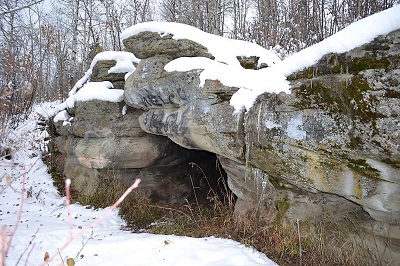Tse'K'wa National Historic Site of Canada
Fort St. John, British Columbia

Image of the cave at the Tse'k'wa site
(© Parks Canada | Parcs Canada)
Address :
12629 Butte Lane, Fort St. John, British Columbia
Recognition Statute:
Historic Sites and Monuments Act (R.S.C., 1985, c. H-4)
Designation Date:
2019-08-16
Other Name(s):
-
Tse'K'wa
(Designation Name)
-
Charlie Lake Cave
(Other Name)
Research Report Number:
2019-04
Description of Historic Place
Tse’K’wa National Historic Site of Canada is an archaeological site situated just north of the community of Fort St. John in the Peace River Regional District of British Columbia. The site is within the traditional territory of the Dane-zaa First Nations. It consists of a wooded boreal terrain, and a cave feature fronted by a large standing sandstone boulder (or “parapet”) set in a bedrock escarpment. The property overlooks Stoddart Creek and Charlie Lake. The boundaries for Tse’K’wa are defined as the legal limits of the property, covering an area of 20,564 square metres.
Heritage Value
Tse’K’wa was designated a National Historic Site of Canada in 2019. It is recognized because: its sequence of dated and relatively undisturbed soil layers is rare in North America and has contributed to an understanding of human settlement and environmental change from the end of the last glacial period 12,500 years ago to 1,000 years ago; the lowermost soil layers held a combination of evidence not found elsewhere in Canada, including Palaeo-Indian stone tools, bones of late glacial animals, indicators that bison were hunted, and two nearly-complete raven skeletons that may reflect early belief systems. The upper soil layers showed nearly continuous human presence after the Palaeo-Indian period and provide key comparative data for the study of the early settlement of western Canada; genetic analysis of the bison remains led to new knowledge of bison speciation, and of the direction of human and animal migrations at the end of the Ice Age. The site’s northerly location suggests that it held a position along an early route of northward migration; for the Dane-zaa First Nations, who are stewards of this site, it is a spiritual place, and a touchstone to their lengthy occupation in the Peace River region.
Tse’K’wa, also known as Charlie Lake Cave, is an exceptional archaeological site and a rare Canadian example of a Palaeo-Indian site with an unusually well-preserved stratigraphic record containing a sequence of archaeological remains that have been radiocarbon dated from ca. 12,500 to 1,000 years ago. This sequence provides a timeline for the postglacial environmental changes to the area over 10 000 years, from an open grassland to a forested environment, as well as evidence of continuous human occupation of the area. DNA evidence from bison bones recovered in the earliest layers of the site shows genetically distinct populations from north and south of the ice sheets during glaciation, now sharing the same area. The presence of a fluted projectile point similar to those found further south suggests that humans had migrated to the region from the south, rather than migrating from the north. Furthermore, the discovery of two relatively undisturbed raven skeletons suggests they may have been deliberately buried and thus may be associated with very early belief-based practices. This has further enhanced the importance of this site for the region’s First Nations since the raven is an important character who conveys life-lessons in many First Peoples histories.
Source: Historic Sites and Monuments Board of Canada, Minutes, June 2019.
Character-Defining Elements
Key elements contributing to the heritage value of this site include: Its location in a wooded area overlooking Stoddart Creek and Charlie Lake situated just north of the community of Fort St. John in the Peace River Regional District of British Columbia; Its cave on the bedrock escarpment; Its large sandstone outcrop (referred to as the “parapet”) which parallels the bedrock escarpment in front of the cave for about 12 meters; Its archaeological material uncovered, and yet to be uncovered, found throughout the property; Its collection of artifacts and faunal remains; The travel routes, landscape meanings, and spiritual associations tied to the broader area of Charlie Lake, as well as to the cave site, that were and remain a central element of continuing Dane-zaa traditions.